Predictions & Data for this entry
| Model: std | climate: Af, Am, Aw, Cs, Cw | migrate: | phylum: |
| COMPLETE = 3.5 | ecozone: THp, TPam | food: biO | class: |
| MRE = 0.172 | habitat: 0iFr, 0iFl, 0iFp, 0iFm, 0iFc | gender: D | order: |
| SMSE = 0.061 | embryo: Fbf | reprod: Apo | family: |
Zero-variate data
| Data | Observed | Predicted | (RE) | Unit | Description | Reference |
|---|---|---|---|---|---|---|
| ah | 20 | 21.25 | (0.06241) | d | age at hatching | VogtToll2004 |
| ab | 45 | 39.47 | (0.1229) | d | age at birth | VogtToll2004 |
| tp | 220 | 203.5 | (0.07492) | d | time since birth at puberty at 20 C | VogtToll2004a |
| am | 1154 | 1175 | (0.0178) | d | life span | Vogt2010 |
| Lh | 0.35 | 0.34 | (0.02863) | cm | total length at hatching | VogtToll2004a |
| Lb | 0.57 | 0.6544 | (0.1481) | cm | total length at birth | VogtToll2004a |
| Lp | 4 | 4.053 | (0.01319) | cm | total length at puberty | VogtToll2004a |
| Li | 10 | 12.25 | (0.2248) | cm | ultimate total length | VogtFalc2015 |
| LCi | 4.5 | 5.207 | (0.1571) | cm | ultimate carapace length | VogtFalc2015 |
| Wwb | 0.0053 | 0.006457 | (0.2183) | g | wet weight at birth | SeitVilp2005 |
| Wwp | 1.537 | 1.533 | (0.002298) | g | wet weight at puberty | SeitVilp2005 |
| Wwi | 30 | 42.32 | (0.4108) | g | ultimate wet weight | VogtFalc2015 |
| Ri | 8.036 | 4.805 | (0.402) | #/d | max reprod rate | VogtFalc2015, VogtDorn2019, HossKoub2019 |
| E0 | 37.54 | 27.59 | (0.265) | J | initial energy content of the egg | RodrGarc2006, VogtToll2004a |
Uni- and bivariate data
| Data | Figure | Independent variable | Dependent variable | (RE) | Reference |
|---|---|---|---|---|---|
| tL1 | 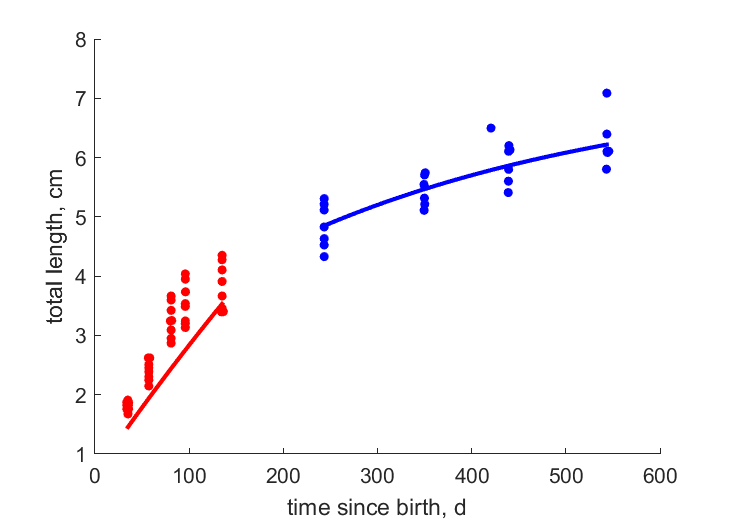 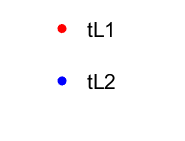 | time since birth | total length | (0.1898) | VogtHube2008 |
| tL2 |   | time since birth | total length | (0.05105) | VogtHube2008 |
| LW_Vogt2010 | 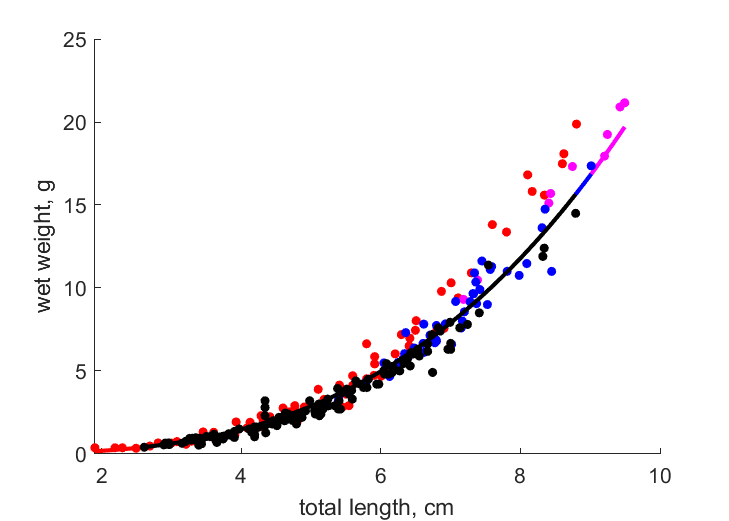  | total length | wet weight | (0.1621) | Vogt2010 |
| LW_ParvTogo2017 |   | total length | wet weight | (0.07716) | ParvTogo2017 |
| LW_Ziza2015 |   | total length | wet weight | (0.08003) | Ziza2015 |
| LW_HossKoub2019 |   | total length | wet weight | (0.1144) | HossKoub2019 |
| LN_Vogt |   | total length | number of eggs | (0.2653) | VogtDorn2019 |
| LN_HossKoub2019 |   | total length | number of eggs | (0.206) | HossKoub2019 |
| tCL30 | 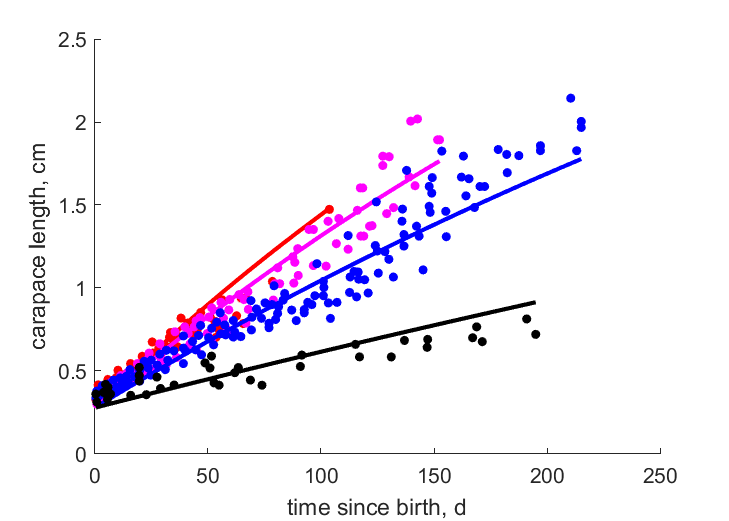 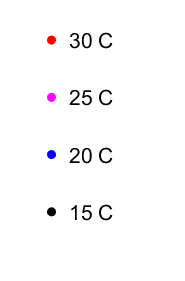 | time since birth | carapace length | (0.1234) | SeitVilp2005 |
| tCL25 |   | time since birth | carapace length | (0.09034) | SeitVilp2005 |
| tCL20 |   | time since birth | carapace length | (0.1028) | SeitVilp2005 |
| tCL15 |   | time since birth | carapace length | (0.1485) | SeitVilp2005 |
| tWw30 |  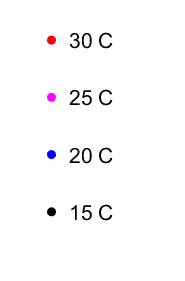 | time since birth | wet weight | (0.6713) | SeitVilp2005 |
| tWw25 |   | time since birth | wet weight | (0.3459) | SeitVilp2005 |
| tWw20 |   | time since birth | wet weight | (0.2646) | SeitVilp2005 |
| tWw15 |   | time since birth | wet weight | (0.8508) | SeitVilp2005 |
| WN | 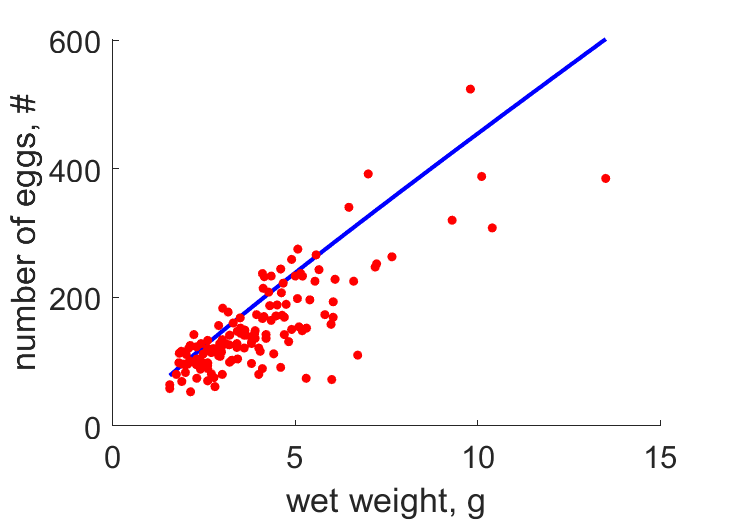 | wet weight | number of eggs | (0.3046) | HossKoub2019 |
| tW | 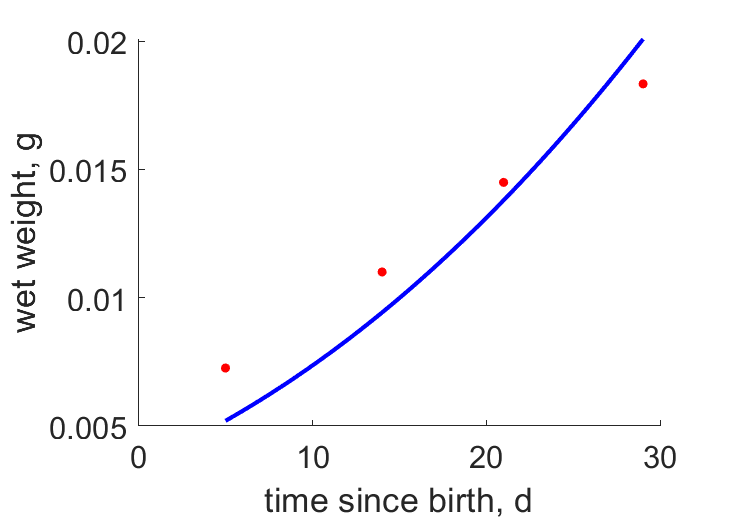 | time since birth | wet weight | (0.1191) | VeliStar2014 |
Pseudo-data at Tref = 20°C
| Data | Generalised animal | Procambarus virginalis | Unit | Description |
|---|---|---|---|---|
| v | 0.02 | 0.01169 | cm/d | energy conductance |
| kap | 0.8 | 0.8424 | - | allocation fraction to soma |
| kap_R | 0.95 | 0.95 | - | reproduction efficiency |
| p_M | 18 | 119.1 | J/d.cm^3 | vol-spec som maint |
| k_J | 0.002 | 0.002 | 1/d | maturity maint rate coefficient |
| kap_G | 0.8 | 0.7963 | - | growth efficiency |
Discussion
- Model std is applied, instead of abj, since freshwater crayfish, unlike marine decapods, have no larval stage
Facts
- Eggs are glued to hairs under the abdomen; after hatching the young continue to cling to the hairs, moult 2 or 3 times and a miniature crayfish walks off (Ref: VogtToll2004a)
- Reproduction exclusively by parthenogenesis, no male specimen found (Ref: VogtToll2004a)
- Not much is known about the species, common in aquariums, best cultured at temperatures of 18-25 C. Maximum growth is obtained at 25 C and maximum survival at 20 C (Ref: VogtToll2004a)
- Life cycle can be subdivided into 5 stages: (1) embryo, (2) juvenile stages 1-3 (brood period), (3) differentiation of sexual organs from stage 4 juveniles to 2cm TL adolescents,(4) gonadal maturatation (2cm to 4cm TL), (5) the adult reproducing period (4cm to 12cm TL). Duration of each stage but also mean size of crayfish at each stagedepend on rearing conditions (Ref: VogtToll2004a)
Bibliography